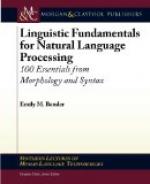* * * * *
Describing adjectives admit of variation to express different degrees of comparison. The regular degrees have been reckoned three; positive, comparative, and superlative. These are usually marked by changing the termination. The positive is determined by a comparison with other things; as, a great house, a small book, compared with others of their kind. This is truly a comparative degree. The comparative adds er; as, a great_er_ house, a small_er_ book. The superlative, est; as, the great_est_ house, the small_est_ book.
Several adjectives express a comparison less than the positive, others increase or diminish the regular degrees; as, whit_ish_ white, very white, pure white; whit_er_, considerable whiter, much whiter; whit_est_, the very whitest, much the whitest beyond all comparison, so that there can be none whiter, nor so white.
We make an aukward use of the words great and good, in the comparison of things; as, a good deal, or great deal whiter; a good many men, or a great many men. As we never hear of a small deal, or a bad deal whiter, nor of a bad many, nor little many, it would be well to avoid such phrases.
The words which are added to other adjectives, to increase or diminish the comparison, or assist in their definition, may properly be called secondary adjectives, for such is their character. They do not refer to the thing to be defined or described, but to the adjective which is affected, in some way, by them. They are easily distinguished from the rest by noticing this fact. Take for example: “A very dark red raw silk lady’s dress handkerchief.” The resolution of this sentence would stand thus:




